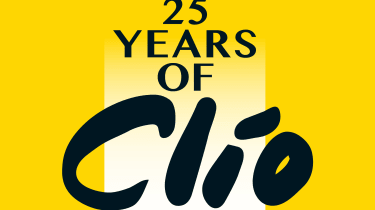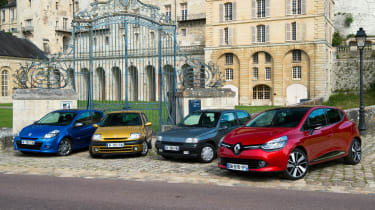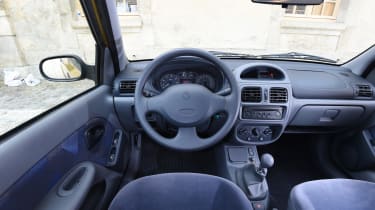Old vs new: Renault Clio Mk4 vs Mk3, Mk2 and Mk1
Success is in the blood of the Renault Clio, and we bring all four generations together for a unique drive
The original Renault Clio landed at the Paris Motor Show in 1990. The name, taken from the Greek “to make famous”, hinted at the brand’s intentions for its new supermini.
The Clio had to trump the success of the Renault 5 by creating big-car refinement in a tiny package; a big little car, as it was coined back then. It went on to be crowned European Car of the Year in 1991. In France, it offered previously unseen amounts of kit, with six engines, two bodystyles and three trim levels, and later spawned sporty S, RSi and Williams versions.
• Best superminis on sale right now
Renault replaced the square original with the curvier Clio II in 1998. This car had plastic wings with an aluminium bonnet, and remained in production for various markets until 2012.
Despite this, the Clio III was unveiled at 2005’s Frankfurt Motor Show, and was named European Car of the Year for the second time in 2006. Most recently, the Clio IV hit Renault dealers in 2013. It was the first car to feature the brand’s new design language, now familiar on the Captur, Kadjar and Mégane. This latest model brought a welcome boost in technology, too.
But the only way to see how far the Clio has come is to drive each generation back-to-back. We took all four versions from Renault HQ near Paris out to the idyllic French countryside north west of the capital.
Redefining the small car
Clio evolved from a successor to a legend to a real class contender, and the first two generations still impress
The wraps were pulled from the original Renault Clio at the Paris Motor Show in autumn 1990, and it went on sale in France later that same year. But it wasn’t until the following spring that we got our hands on the car in the UK.
It was well worth the wait, as the Clio improved on the legendary Renault 5 it replaced in near enough every area. Way back in Auto Express Issue 121, we praised the Clio I for being “comfortable, refined and responsive”, heralding it as a car that “loves to be driven”. It’s easy to see why it was awarded the coveted European Car of the Year title in 1991, ahead of the Nissan Primera and Vauxhall Calibra.
• Renault Clio: how the legend was conceived
But the most amazing thing is how modern the original Clio feels to drive even today. The steering is beautifully weighted, while the dinky dimensions and large windows mean it’s a doddle to manoeuvre around town. Our car had the popular 79bhp 1.4-litre petrol engine, although instead of the desirable five-speed manual gearbox, this model was paired with a power-sapping automatic.
Still, out on the open road, it handled with poise, echoing the fun nature of its predecessor while also feeling much more grown-up. The interior is a little conservative by today’s standards, but there’s plenty of space and it all feels well built. The analogue dials look incredibly dated, too, although they’re functional and easy to read.
In the back, there’s a surprising amount of room for passengers. In fact, some modern-day city cars could learn a thing or two from the original Clio. Granted, crash testing and safety legislation are much more stringent today, but the 25-year-old Clio proved compact exterior dimensions needn’t come at the expense of space.
While many manufacturers play it safe when introducing an all-new model, Renault ripped up the rulebook on the unveiling of the Clio II in 1998. Gone was the boxy shape and conventional lines, replaced by a more bulbous and rounded body. It was an immediate success, with the stronger, more sophisticated silhouette winning the hearts of buyers all over Europe. Advanced materials were used throughout to minimise potential weight penalties, with polycarbonate headlamp covers, composite front wings and, on some models, an aluminium bonnet. Improvements were made in safety, too, with ABS available on selected versions and up to four airbags on top-spec cars.
Just as the Mk1 bettered the Renault 5, the Clio II built on the original car’s engaging handling with a selection of more powerful four-cylinder petrol and diesel engines. Our model was an early ‘Phase 1’ with the 1.9-litre diesel engine and a five-speed manual gearbox. Still in pristine condition, it had covered only a few hundred kilometres from new, and felt as tight as the day it left the factory.
The interior was a big step up from the original Clio’s, too, and while it’s still awash with dreary grey plastics, the digital screen between the dials gives it a more modern feel. The patterned seats bring a welcome splash of colour, along with the slightly lurid gold paint, but there’s no ignoring the basic stereo and bulky three-spoke steering wheel.
• Renault Clio tech innovations
On the road, however, the Clio II turns in sharply, and the torquey diesel is a lively performer. The manual box is preferable to our Mk1 test car’s slow auto, but the throw is long and not all that precise. The ride is well cushioned on the tiny 14-inch wheels and high-profile tyres, lending itself to motorway journeys without breaking a sweat – unlike us as we suffer in the French summer heat without any air-con.
Forward thinking
Mk3 and Mk4 also star on the road, with focus on safety, tech and driver appeal as Clio has moved into the 21st century
While Clio II production continued in various markets until 2012, the third-generation car was revealed back in 2005. Less than 12 months later, it was crowned European Car of the Year, making the Clio the first car to win the award twice.
Renault changed the formula again with the Clio III, replacing the bubbly shape of the Mk2 with a boxier and more chiselled design. Our facelifted car arrived in 2009 with revised headlights and bumpers, as well as a better- quality interior and all-new GT specification as seen here.
• Win a Renault Clio for 6 months
Priorities for the new model revolved around safety; it was the first model in its class to achieve a five-star Euro NCAP crash test rating. Special ‘big car’ features included a tyre pressure monitoring system and a hands-free key card.
The safer styling transferred to the handling, feeling more solid and sensible than the Clio II. On the road, the Mk3 lost some of the second generation’s va va voom, reiterating Renault’s push for a big-car feel in a small package.
While the steering doesn’t have the original’s feedback, there’s plenty of get up and go from the naturally aspirated 126bhp 1.6-litre four-cylinder engine. This is the first of our Clios to dip under the 10-second barrier for the 0-62mph sprint, which comes in handy as we turn off the motorway and on to some twisty roads in rural northern France. It’s a pity we’re not sat in the famed 197bhp Clio RS – a car that’s still regarded as one of the all-time great hot hatches.
In terms of ride, this Clio III feels much more planted and suited to longer drives, but the larger wheels and stiffer GT suspension mean it isn’t as supple as the golden Mk2.
Not surprisingly, the biggest engineering advances are evident when we climb aboard the latest model. Design boss Laurens van den Acker unveiled the car at the 2012 Paris Motor Show, deliberately encapsulating everything that made the previous Clios great, while adding a modern slant and plenty of cutting-edge technology.
• History of the Renaultsport Clio
The longer body means it’s roomier inside than past models, while the design – still fresh today – was the first of the present family that has since spawned the Captur, Kadjar and Mégane. Styled to appeal to young buyers and families alike, this was the first Clio to be available solely as a five-door. However, the sleek, handle-free rear doors gave a coupé-like profile with a more youthful edge.
Inside, the car has been totally transformed. Gone is the grey plastic dashboard and cumbersome steering wheel, replaced by gloss plastics, digital dials and a big central touchscreen. Connectivity is key on the Clio IV, with the debut of Renault’s R-Link infotainment system, incorporating Bluetooth, sat-nav and app integration for seamless smartphone connection on the move.
From behind the wheel, it feels as though we’ve turned full circle; as with our Mk1, our Clio IV comes fitted with an automatic gearbox. However, the dual-clutch set-up in the new car is smooth, fast and efficient, with steering wheel-mounted paddles for quick changes and greater control. There’s no sensation of it draining power, either, with the turbocharged petrol engine comfortably trouncing both the early cars for straight-line pace.
The ride is well judged, and despite feeling smooth and settled on the motorway, the Clio IV still has enough composure to take faster corners with relish. The steering is precise and the engine quiet, while in the back there’s enough room for taller adults to sit in comfort. In fact, it feels more like the Mk1 than the Clio III in that sense.
Now the facelifted Clio IV has landed, the supermini looks sure to continue its surge on the global small car market – with 12 million sales and counting.
Renault Clio Special
We celebrate a quarter of a century of Renault's supermini with real va-va-voom...

- • Win a Renault Clio for 6 months
- • Renault Clio: secrets of how the brand was born
- • Exploring the Mk4 Clio with the man who designed it
- • The Renault Clio's best special editions
- • Renault Clio tech innovations
- • Old vs new: the Renault Clio through four generations
- • History of the Renaultsport Clio
- • Renault EOLAB: the future of Renault
Find a car with the experts















